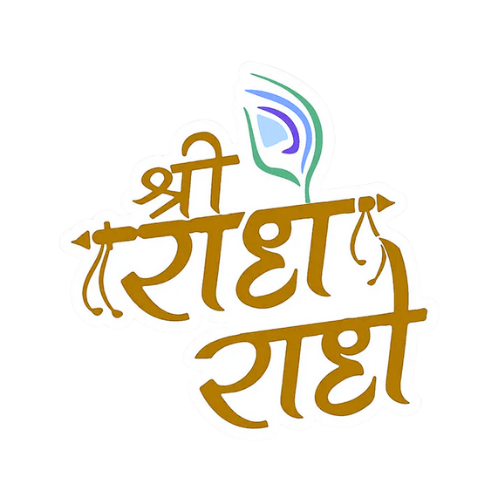
Close

The sacred village where Kanha’s laughter, mischief, and innocence turned eternity into childhood
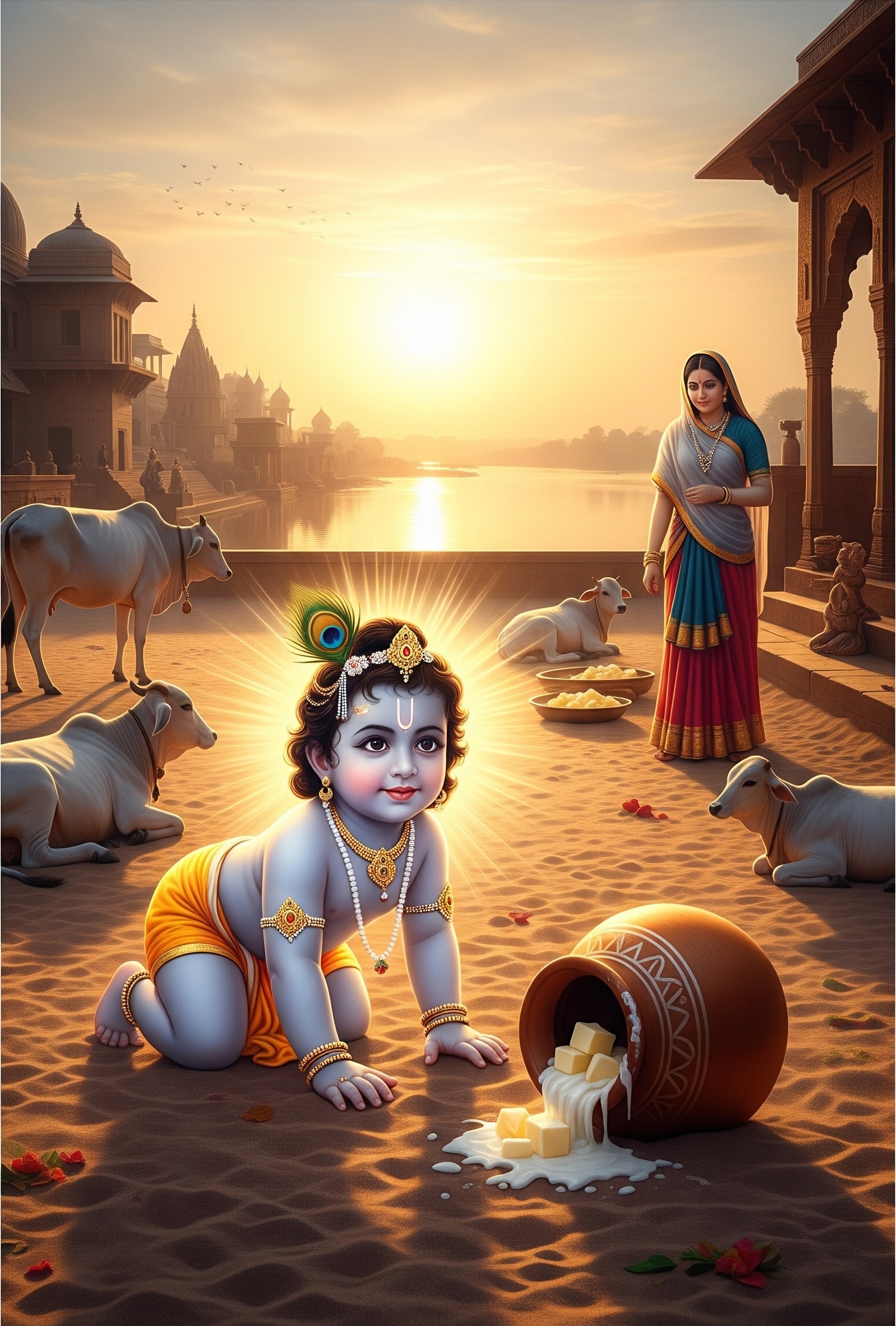
Introduction If Mathura is the majestic birthplace of Krishna, Gokul is His tender childhood home. Here, the boundless Lord became Nanda-Yashoda’s darling boy — crawling in dust, stealing butter, and filling every courtyard with laughter. The scriptures remind us that Gokul is not merely a village but the cosmic playground where the Infinite chose to be touched, embraced, and mothered. Divine Experience Pilgrims in Gokul feel less like visitors and more like family. The mood is not one of awe toward God, but of affection for a beloved child. Chanting “Lala” or “Shyam” in Gokul feels natural, as if the little Krishna still runs barefoot through the lanes. The heart softens here — from devotion that seeks the Divine, to love that holds Him in its arms. Architecture & Atmosphere The essence of Gokul is not its grand structures but its homely simplicity. Mud-walled courtyards, goshalas filled with cows, Yamuna ghats where mothers bathe children — these are the living temples of Gokul. Even in stone temples like Nanda Bhavan, the atmosphere is warm and familial, echoing not the majesty of palaces but the sweetness of home. The air itself carries the fragrance of butter, cow dung, and incense — the fragrance of Krishna’s boyhood.
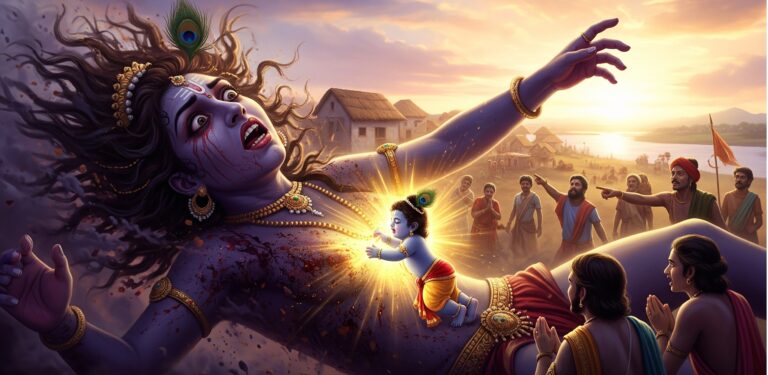
When the cruel demoness Putana entered Gokul, the peaceful village never imagined such danger could disguise itself in beauty. She came adorned with ornaments and dressed like a motherly figure, her face glowing with deceptive charm. Her wicked heart carried only one thought — to kill the infant Krishna by offering Him poisoned milk.
Yet, the moment Putana lifted the Divine Child into her arms, something within her trembled. Krishna’s lotus-like eyes, sparkling with innocence and divinity, pierced straight into her being. She placed Him to her breast, but instead of her poison conquering Him, the opposite happened. The Lord drank her milk — and along with it, He drank away her sins, her darkness, and her very life.
Putana fell lifeless, assuming her gigantic demonic form. But Krishna, with infinite compassion, granted her moksha — liberation, as if she were His very mother. The people of Gokul marveled at the sight, realizing that this divine child was not ordinary.
Even today, devotees bow their heads at Putana Mokshan Sthal in Gokul, remembering that Krishna’s mercy knows no boundaries — even a demoness found salvation at His lotus feet.
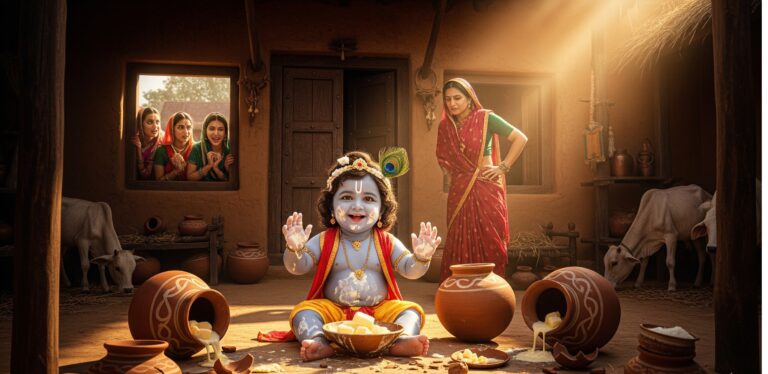
In every home of Gokul, butter was churned with devotion — but no pot of butter was safe when little Krishna was around. His love for makhan (butter) became legendary. The gopis tried everything to protect their treasured pots: they tied them high above the ground, locked them inside storage rooms, or covered them with heavy lids. But Krishna, the clever little butter-thief, always found a way.
Climbing on His friends’ shoulders, breaking the pots with stones, or secretly sneaking in during the early morning hours — nothing could stop Him. With His tiny, butter-smeared hands and twinkling eyes, He would share the stolen treasure with His cowherd friends and even the monkeys of Gokul.
When the gopis, in mock anger, rushed to Yashoda Maiya to complain, she too tried to scold her son. But one glance at His mischievous smile, His lips shining with butter, and her heart melted. Instead of punishment, she could only embrace Him with love.
Thus, Krishna as Makhan Chor taught the world a deeper secret — the Lord steals not our butter, but our hearts, filling them with divine sweetness.
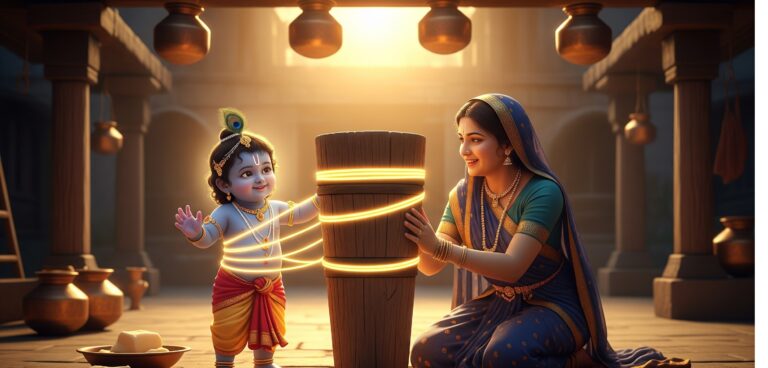
One day, after endless pranks and butter thefts, Yashoda Maiya decided to discipline little Krishna. With determination, she tried to tie Him to a heavy grinding mortar (ukhal) to keep Him in place. But a divine mystery unfolded: every rope she tied was always two fingers short. She brought more rope, tied again — yet it still remained short.
Sweating, exhausted, yet filled with motherly love, Yashoda never gave up. Finally, seeing her sincere devotion and affection, Krishna allowed Himself to be bound. The mortar became His playful seat, but this leela revealed an eternal truth:
Krishna cannot be bound by rope, wealth, or power — He is bound only by pure love and bhakti.
This event is celebrated as Damodar Leela, reminding us that devotion softens even the infinite Supreme Being.

On the stormy night of Krishna’s birth, His father Vasudeva carried the newborn across the mighty river Yamuna. Dark clouds roared, rain poured, and the river swelled with fierce waves. Yet when Yamuna saw the Divine Child resting in Vasudeva’s arms, her heart overflowed with devotion.
Instead of stopping them, Yamuna rose gently, touching Krishna’s tiny lotus feet with her waves. She bowed down, offering her eternal service to the Lord. At that moment, the storm calmed, the waters parted, and Vasudeva crossed safely to Gokul.
To this day, devotees remember Yamuna Maiya’s miracle as the ultimate example of bhakti — even the mighty river longed to touch and serve her Beloved Krishna.